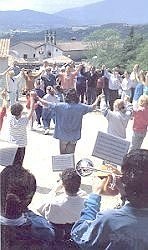Festivals and Traditions
Catalonia's unique cultural identity is manifested in a variety of festive activities that are particular to this autonomous region. Some occasions, such as Easter, Saint George's Day, and the night of Sant John on the summer solstice, take place all over Catalonia. Many other festivals are local. Each neighborhood, town, or village has its patron saint and sets aside a day to honor him in a festa major. These festivals often feature some of the activities described here below.
 What are Castells?
What are Castells?
Local festivals, particularly in summer months, may also include castellers, a relatively serious event where young men and women in traditional costume (xiquets) form human towers to the strains of an orchestra (the cobla), which announces with strange but often engaging music, the different steps in the building process. This extraordinary Catalan speciality, usually held in the plaza in front of the mayor's office (ajuntament) is frought with danger for its participants. Performers(castellers) deftly climb onto one another's shoulders to form a human pyramid (castell, or castle). The better of the colles (performing groups) build varying structures as much as nine or ten stories high, topped by a small boy or girl called (enxaneta) or the weathercock. How they all don't get injured when the castells collapses - as castells often do - is a mystery. This is really a must-see event. You'll never forget it!
What are Sardanas
At many festivals, you are likely to see circles of people dancing the sardana, Catalunya´s national dance, and one which resembles no other Spanish dance. Its origins are thought to lie in the graceful dances of ancient Greece (which you can still see depicted on antique pottery in museums throughout the Mediterranean). One theory is that the Greeks introduced the dance during the period in which they maintained trading posts on Catalunya´s northern shores thousands of years ago. Others insist that the sardana was not practiced here until the fifteenth-century Catalan occupation of Sardinia, hence the name. In any case, the sardana in its present form emerged during the Renaixença (the 19C. Catalan renaissance) and had become so much a symbol of national identity that it was banned during the Franco period.
 Sardana dancers link hands with raised arms, forming circles which grow bigger and bigger as more people join in. Traditionally, couples can join in at any point, but cannot cut in between a man and his partner on the right. When the circle gets too big, the dancers form more circles. One of the main features of the dance is its spontaneity - for instance, except on special occasions, dancers wear everyday clothes, (although the lace-up espadrille shoe is a perennial favorite for its pliability and comfort). People of all ages and ranks in life join hands and dance as if to emphasize that whatever their differences, they are first and foremost Catalans. The spirit of unity generated by the sardana is truly impressive. An extremely disciplined dance, the sardana calls for exact movements and expert timing, provided by a leader in each circle. For this reason, unless you think you´ve really got the knack, it's generally inadvisable for visitors to join in - one wrong move can put the entire circle out of step.
Sardana dancers link hands with raised arms, forming circles which grow bigger and bigger as more people join in. Traditionally, couples can join in at any point, but cannot cut in between a man and his partner on the right. When the circle gets too big, the dancers form more circles. One of the main features of the dance is its spontaneity - for instance, except on special occasions, dancers wear everyday clothes, (although the lace-up espadrille shoe is a perennial favorite for its pliability and comfort). People of all ages and ranks in life join hands and dance as if to emphasize that whatever their differences, they are first and foremost Catalans. The spirit of unity generated by the sardana is truly impressive. An extremely disciplined dance, the sardana calls for exact movements and expert timing, provided by a leader in each circle. For this reason, unless you think you´ve really got the knack, it's generally inadvisable for visitors to join in - one wrong move can put the entire circle out of step.
Along with the sardana, there are numerous other traditional dances specific to different towns or regions, often performed in local costume and evoking formative episodes of the area´s mythologies.
